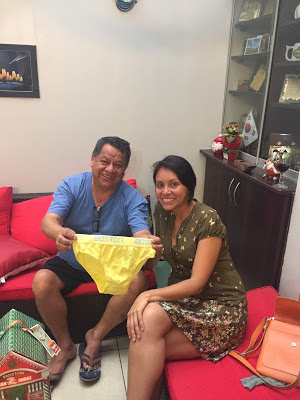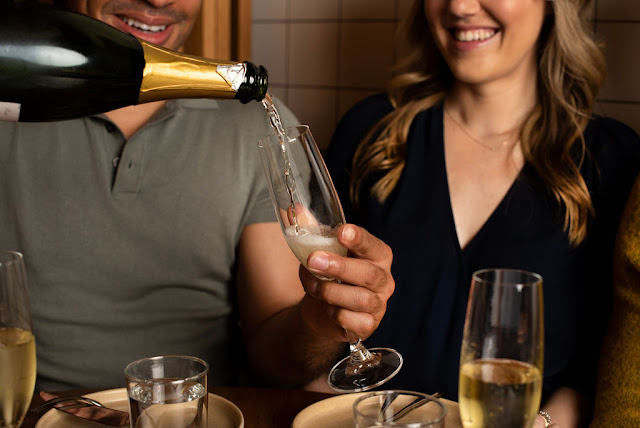Quirky New Year’s Traditions around the World and Observances Continuing in January: Japan and More
I’ve already broken my New Year’s resolution. I had said I
was going to observe Dry January this year. Or maybe even try for a Dry January week to
detox after the holidays. My new-found loves for sake and Japanese whiskey,
after my visit to Tohoku, made mincemeat of those resolutions.
So, instead of starting the year on a more somber,
restrained note, I’ve decided to look at how other countries ring in the New
Year, to see if my “not so restrictive” orientation is heading me in the right
direction.
Japan is very serious about celebrating
New Year’s with both religion and food.
You might think of Tokyo’s version
of Times Square, Shibuya Crossing, as the place to be in Japan on New Year’s Eve. But many choose to visit a more spiritual
place to welcome the year ahead. Locals observe a tradition of Hatsumōde, the first Shinto shrine visit
of the New Year. At the shrine, a talisman with the previous year’s zodiac sign
is burned -- a ritual called Otakiage
-- and is replaced with the zodiac animal of good fortune for the year ahead.
Listening to Joya-no-Kane,
108 rings of the ōgane great bell at a Buddhist temple, is also a New Year’s
tradition in Japan with each peal “ringing away” an evil passion or desire (bonnou) for a clean start to the year.
The celebration continues with the customary slurping of bowls of toshikoshi soba or “the
end-of-the-year-and-into-the-next” soba noodles, symbolizing the bridge between
the “old year” and “new year.” The shape and length of soba are associated with
a lean and long life. As soba noodles are easier to cut than other noodles,
eating them is said to symbolize “cutting away bad luck.”
 |
| Yahiko Shrine, Niigata, credit: Meryl Pearlstein |
In addition to soba, New Year in Japan is celebrated with
foods associated with wishes for good luck, good harvest and other positive outcomes.
A traditional Osechi Ryori meal is
served in a special jubako box.
Consisting of multiple colorful dishes, the meal is to be eaten with special
chopsticks that are rounded on both ends, one end for human use and the other
for the gods. Each dish represents a symbol or a wish for the coming year. Some
of the traditional dishes include kazunoko,
pacific herring roe marinated in salt (representing the wish for an abundant
harvest and fertility); kuromame,
sweet black soybeans (representing hard work and good health); tazukuri, dried young anchovies (another
wish for a strong and abundant crop) and kuri-kinton,
candied chestnut with sweet potatoes (symbolizing economic fortune and wealth).
Separate from this, Japanese sea bream is grilled in
salt for the New Year and left untouched for the first three days of the year
as an offering to the gods. After that,
it’s ready to eat. If this isn’t enough, you can try ozoni, a soupy concoction made with a dashi-like broth, pieces of
mochi, vegetables and sake-marinated chicken. It’s another of Japan’s
traditional foods for the New Year and another way to enjoy mochi which is
associated with luck and longevity.
There are some very nice airfares to Japan now, and you
still have time to attend The Dontosai
Festival on January 14 at shrines in the Miyagi prefecture in the Tohoku region. The largest observance is held at the Osaki
Hachiman Shrine in Sendai City where people come to burn their previous year’s New
Year's decorations in a massive bonfire. Seen as a purification ritual to get
rid of bad luck as well as a way to pray for health and good fortune, the
bonfire is also accompanied by hadaka-mairi,
a pilgrimage of men dressed only in white boxers, loincloths, a straw belt and
straw shoes who ring a hand bell to herald the coming year while cleansing
themselves of the previous year. Spectators can join in the event by partaking
in festival foods sold along the route.
10 Other Places Where
New Year’s is Kind of Quirky
Community bonfires are also a New Year's Eve event
throughout Iceland. These massive fires are a
chance for friends, families and neighbors to gather in the early evening,
reflect on the year behind them and spread well wishes for the year ahead.
Locals sing traditional songs about the year gone by and about elves, the
secret creatures of Icelandic lore, before scurrying indoors at 10:30pm to watch
Skaupið, a satirical TV show shown only on NYE. No one in Iceland would dream
of missing it!
The way to say goodbye to the old year in Mexico differs by area. In some
regions, a doll made of old rags is set on fire to symbolize the burning of the
previous year’s bad memories or deeds. In Veracruz
popular music floods the streets and children celebrate “El Viejo,” disguising
themselves as elders as a representation of the end of the previous year. In Oaxaca, breaking crockery as a symbol
of getting rid of the old is a New Year’s Eve tradition. In the heart of
Jalisco, the town of Tequila fêtes the
end of the year by eating 12 “lucky” grapes, one for each chime of the clock,
as they do in Spain. Adding a local
twist, Tequila welcomes the New Year with a secret wish and a toast of tequila,
not surprisingly, rather than with Spanish cava. For extra good luck, locals drop
a gold jewel inside their tequila glass as a token of luck and abundance for
the coming months.
The evening of December 31 is spent in Italy
eating boiled lentils at a cenone, a
traditional dinner held to celebrate the new year. It is believed that if you
eat lentils at midnight, you are guaranteed good luck and lots of money in the
year ahead. Dating from ancient times,
the roundly shaped lentils were stored in small pouches that resembled coins. When
cooked, the lentils double in size, symbolizing growth and abundance.
 |
| Lentils for New Year's, courtesy of Grand Hotel Miramare |
 |
| Hoppin' John, courtesy of Discover South Carolina |
Similar to the Italians, folks in South
Carolina (United States) have their own good luck recipe for New
Year’s. Derived from the Gullah culture, Hoppin’ John, a peas and rice dish, is
made with black-eyed peas viewed as good-luck coins. To increase the chances of
receiving a lot of money in the New Year, Hoppin’ John is often served with
collard greens said to represent dollar bills. Some people even place a penny
underneath the Hoppin’ John dish to bring a little extra luck to the family.
But it may be these South American and European countries
that have the most fun (or insanity) on New Year’s Eve.
To ensure good luck and positive energy, Peruvians don yellow clothing, wearing the color of Peruvian positivity. For double assurance, many wear yellow underwear and even start their New Year’s Eve celebration wearing their underwear inside out. After the clock strikes midnight, they turn it back to the right side, symbolizing changes to be made in the coming year.
To ensure good luck and positive energy, Peruvians don yellow clothing, wearing the color of Peruvian positivity. For double assurance, many wear yellow underwear and even start their New Year’s Eve celebration wearing their underwear inside out. After the clock strikes midnight, they turn it back to the right side, symbolizing changes to be made in the coming year.
Then there are the Colombians who take an empty
suitcase on New Year’s Eve and run around the block as quickly as possible to
ensure a year full of travel. I kind of love that one! Probably no one in New York would even notice
if I did that on New Year’s Eve.
I’m sure that my neighbors would have me committed if I did this, but in Denmark people smash plates against their friends’ and loved ones’ front doors on New Year’s Eve. It is believed that the person who ends up with the largest pile of broken plates will have most luck in the coming year. If your pile is smaller, you can judge accordingly. I thought only the Greeks did this in the Plaka.
The Greeks do smash something on New Year’s Eve, but it’s
not plates. It’s a pomegranate. In Greece, homemakers hang the fruit
outside their front door and smash it. The number of seeds that fall determines
your fate for the New Year. The bigger the pile, the better your luck will be.
And then there are two more celebrations that extend into
January.
On December 31, Russians party with friends and
family at home with an elaborate food spread with mandarins, Russian salad
(Olivier salad) and the wonderfully named “Herring under the Fur Coat” salad (shuba). Because there are nine time
zones in Russia, New Year is celebrated nine times starting from Vladivostok
from East to West. But there’s more. Everything must be prepared to last for
the next ten days, a tradition that dates back to surviving the ten long, winter
days of public holidays leading to Orthodox Christmas on January 7. So you have
until January 7 to finish celebrating New Year’s before you celebrate Christmas
for a second time.
Looking for an extended holiday celebration that’s perhaps a
bit more spirited and family friendly? Besides traveling to Japan for the Dontosai
Festival or to Russia for Orthodox Christmas, you still have time to make it to
Spain
for the Blessing of the Animals. Every year on January 17, thousands of people
follow the centuries-old tradition of bringing their pets to churches around
Spain to be blessed by the patron saint of animals. It’s like
the one celebrated at St. John the Divine in New York City on the first weekend
in October.







Comments
Post a Comment